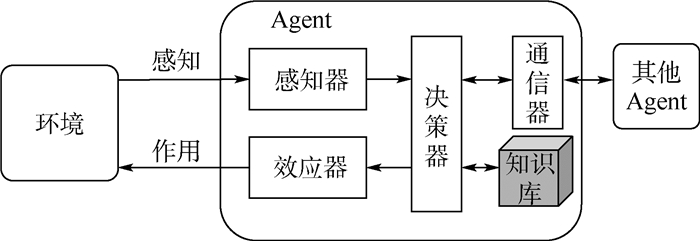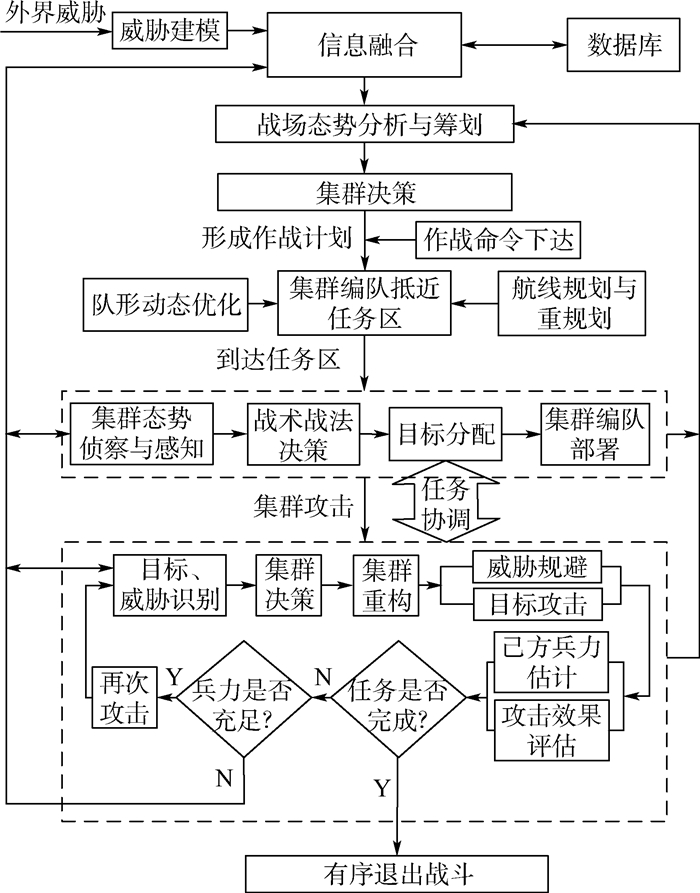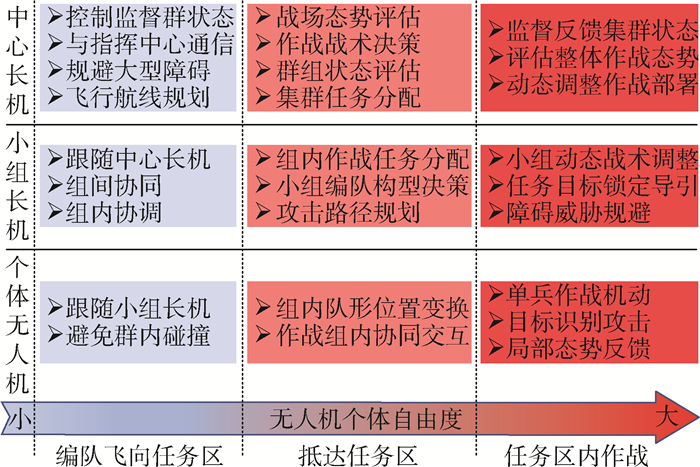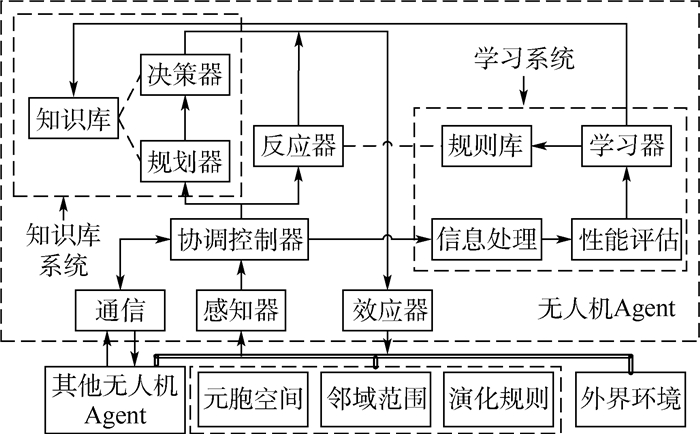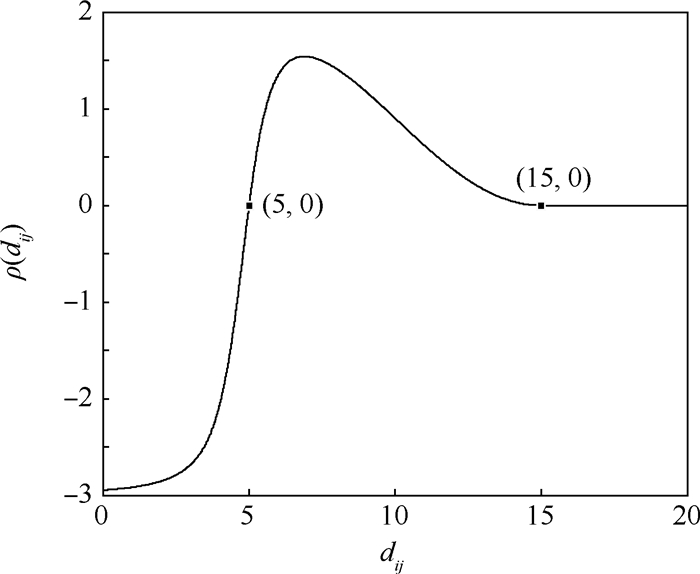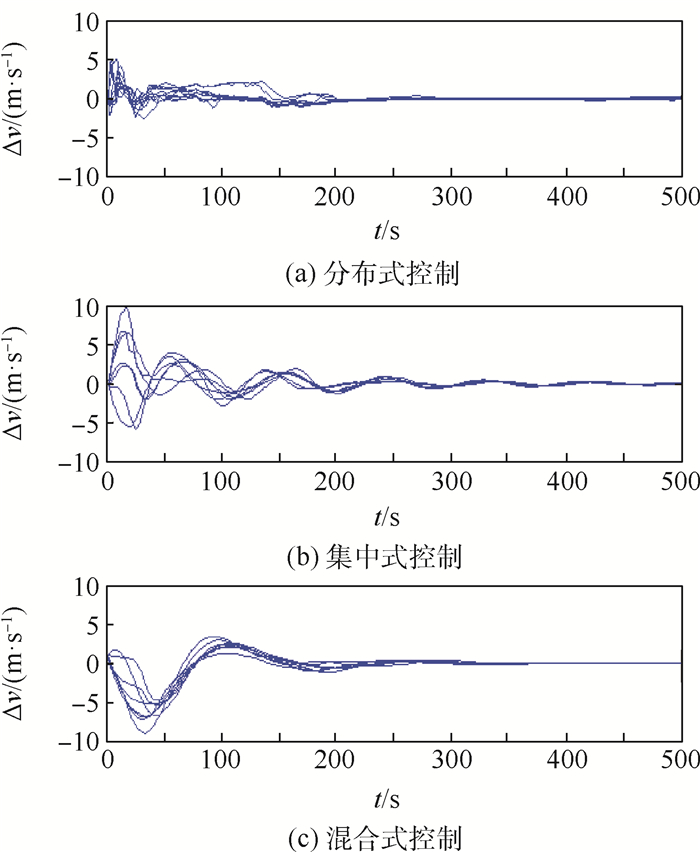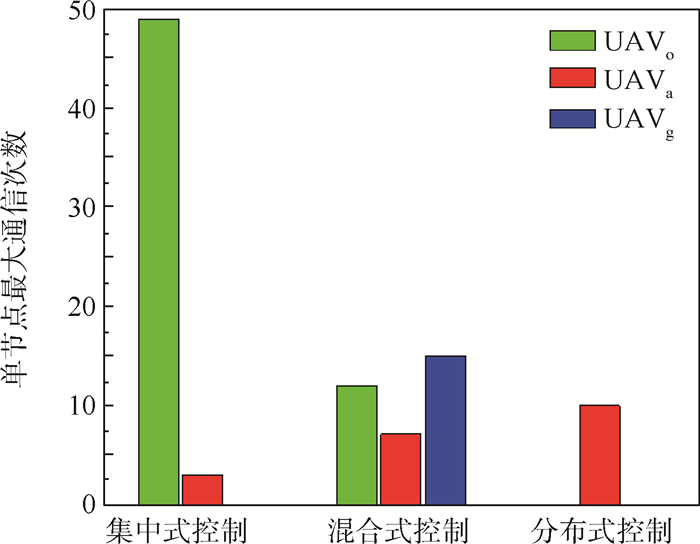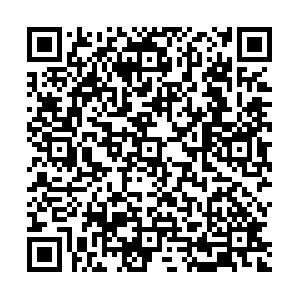-
摘要:
高效有序的集群控制方式是集群顺利完成作战任务的前提。针对无人机集群控制问题,结合集中式与分布式2种控制方式,提出基于Agent与元胞自动机的集群混合式控制。从无人机集群作战流程出发构建了无人机集群控制体系框架、通信拓扑结构及集群控制规则,将集群个体由上至下分为中心长机、小组长机、个体无人机3个层次,高层级对低层级采用自上而下的集中式控制,同层级采用自下而上的分布式控制。在此基础上,利用Agent模型的层次性与元胞自动机模型的同质性,设计了基于Agent与元胞自动机的集群混合式控制模型,实现2种控制方式有效结合,元胞自动机模型实现集群基本的聚合、分离、速度一致规则,Agent模型实现不同层级个体间的协同交互规则。在编队集结与保持任务背景下,对分布式、集中式与混合式3种控制进行对比仿真,结果表明:基于混合式控制的集群在编队可控性、跟随性、一致性以及降低通信负载等方面具有明显优势,验证了混合式集群控制方法的有效性。
Abstract:The efficient and orderly swarms control mode is the prerequisite for the swarms to successfully complete the combat mission. Aimed at the problem of UAV swarms control, a hybrid swarms control based on Agent and cellular automata is proposed by combining the centralized and distributed control modes. Based on the analysis of UAV swarms operation flow, the framework of UAV swarms control system, communication topology and swarms control rules are constructed. The swarms' individuals are divided from top to bottom into three levels: center leader, group leader, and individual UAV. The upper level adopts top-down centralized control to the lower level, and the same level adopts bottom-up distributed control. On this basis, using the hierarchy of Agent model and the homogeneity of cellular automata model, a swarms hybrid control model based on Agent and cellular automata is designed to realize the effective combination of the two control modes. The cellular automata model realizes the basic swarms rules of aggregation, separation and uniform speed, and the Agent model realizes the cooperative interaction rules among individuals at different levels. Under the background of formation assembly and maintenance task, three kinds of control: distributed, centralized and hybrid, are compared and simulated. The simulation results show that the swarms based on hybrid control have obvious advantages in formation controllability, following, consistency and reducing communication load, which verifies the effectiveness of the hybrid swarms control method.
-
Key words:
- UAV swarms /
- hybrid structure /
- formation control /
- Agent model /
- cellular automata
-
表 1 仿真参数
Table 1. Simulation parameters
参数 数值 参数 数值 Vmax/(m·s-1) 100 ω3 1 umax/(m·s-2) 7 cm1, m∈Mg 0.1 R0/m 50 cm2, m∈Mg 0.2 γ 0.1 cm3, m∈Mg 0.1 h 0.7 cm4, m∈Mg 0.2 a 1 λ1 1 b 2 λ2 1 c1 0.1 λ3 1 c2 0.2 ci1, i∈Ua 0.1 θi/(°) 45 ci2, i∈Ua 0.2 κ 6 ci3, i∈Ua 0.1 ϕ/(°) 150 ci4, i∈Ua 0.2 β1 1 b1 0.1 β2 1 b2 0.1 co1 0.1 b3 0.1 co2 0.2 b4 0.1 ω1 1 b5 0.1 ω2 1 Vomin/(m·s-1) 60 -
[1] DUAN H B, YANG Q, DENG Y M, et al. Unmanned aerial systems coordinate target allocation based on wolf behaviors[J]. Science China Information Sciences, 2019, 62(1): 205-207. [2] FAELDEN G E U, VICERRA R R P, GAN L L A, et al. Implementation of swarm social foraging behavior in unmanned aerial vehicle (UAV) quadrotor swarm[J]. Journal of Advanced Computational Intelligence and Intelligent Informatics, 2018, 21(2): 197-204. [3] 郑繁繁, 张立冬, 赵浦媛, 等. 启发式无人机蜂群自组网协议及仿真[J]. 指挥与控制学报, 2020, 6(1): 50-59. doi: 10.3969/j.issn.2096-0204.2020.01.0050ZHENG F F, ZHANG L D, ZHAO P Y, et al. The protocol and simulation of swarm self-organizing network for heuristic UAV[J]. Journal of Command and Control, 2020, 6(1): 50-59(in Chinese). doi: 10.3969/j.issn.2096-0204.2020.01.0050 [4] 王祥科, 刘志宏, 丛一睿, 等. 小型固定翼无人机集群综述和未来发展[J]. 航空学报, 2020, 41(4): 20-45.WANG X K, LIU Z H, CONG Y R, et al. Miniature fixed-wing UAV swarms: Review and outlook[J]. Acta Aerophenica Sinica, 2020, 41(4): 20-45(in Chinese). [5] LIU W, GAO Z J. A distributed flocking control strategy for UAV groups[J]. Computer Communications, 2020, 153: 95-101. doi: 10.1016/j.comcom.2020.01.076 [6] FU X W, PAN J, WANG H X, et al. A formation maintenance and reconstruction method of UAV swarm based on distributed control[J]. Aerospace Science and Technology, 2020, 104: 105981. doi: 10.1016/j.ast.2020.105981 [7] LIU H, MENG Q Y, PENG F C, et al. Heterogeneous formation control of multiple UAVs with limited-input leader via reinforcement learning[J]. Neurocomputing, 2020, 412: 63-71. doi: 10.1016/j.neucom.2020.06.040 [8] ROLDAO V, CUNHA R, CABECINHAS D, et al. A leader-following trajectory generator with application to quadrotor formation flight[J]. Robotics and Autonomous Systems, 2014, 62(10): 1597-1609. doi: 10.1016/j.robot.2014.05.002 [9] WILSON D B, GOKTOGAN A H, SUKKARIEH S. Vision-aided guidance and navigation for close formation flight[J]. Journal of Field Robotics, 2016, 33(5): 661-686. doi: 10.1002/rob.21637 [10] HUO M Z, DUAN H B, YANG Q, et al. Live-fly experimentation for pigeon-inspired obstacle avoidance of quadrotor unmanned aerial vehicles[J]. Science China Information Sciences, 2019, 62(5): 052201. doi: 10.1007/s11432-018-9576-x [11] 霍梦真, 魏晨, 于月平, 等. 基于鸽群智能行为的大规模无人机集群聚类优化算法[J]. 中国科学: 技术科学, 2020, 50(4): 475-482.HUO M Z, WEI C, YU Y P, et al. A large-scale UAV clustering optimization algorithm based on pigeon swarm intelligent behavior[J]. Scientia Sinica: Technical Science, 2020, 50(4): 475-482(in Chinese). [12] 杨之元, 段海滨, 范彦铭. 基于莱维飞行鸽群优化的仿雁群无人机编队控制器设计[J]. 中国科学: 技术科学, 2018, 48(2): 161-169. doi: 10.3969/j.issn.0253-2778.2018.02.011YANG Z Y, DUAN H B, FAN Y M. Formation controller design based on levi-flight pigeon swarm optimization[J]. Scientia Sinica: Technical Science, 2018, 48(2): 161-169(in Chinese). doi: 10.3969/j.issn.0253-2778.2018.02.011 [13] QIU H X, WEI C, DOU R, et al. Fully autonomous flying: From collective motion in bird flocks to unmanned aerial vehicle autonomous swarms[J]. Science China Information Sciences, 2015, 58(12): 211-213. http://www.cnki.com.cn/Article/CJFDTotal-JFXG201512016.htm [14] JIA X, HU L H, FENG F J, et al. Robust H∞ consensus control for linear discrete-time swarm systems with parameter uncertainties and time-varying delays[J]. International Journal of Aerospace Engineering, 2019, 2019: 1-16. [15] ZHEN Z Y, TAO G, XU Y, et al. Multivariable adaptive control based consensus flight control system for UAVs formation[J]. Aerospace Science and Technology, 2019, 93: 105336. doi: 10.1016/j.ast.2019.105336 [16] 闫党辉, 章卫国, 陈航, 等. 具有时延和干扰约束的多无人机滑模一致性编队控制研究[J]. 西北工业大学学报, 2020, 38(2): 420-426. doi: 10.3969/j.issn.1000-2758.2020.02.024YAN D H, ZHANG W G, CHEN H, et al. Research on sliding mode consistent formation control of multi-uav with delay and interference constraints[J]. Journal of Northwest University of Technology, 2020, 38(2): 420-426(in Chinese). doi: 10.3969/j.issn.1000-2758.2020.02.024 [17] DENNUNZIO A, FORMENTI E, GRINBERG D, et al. Dynamical behavior of additive cellular automata over finite abelian groups[J]. Theoretical Computer Science, 2020, 843: 45-56. doi: 10.1016/j.tcs.2020.06.021 [18] JETTO K, TAHIRI Z, BENYOUSSEF A, et al. Cognitive anticipation cellular automata model: An attempt to understand the relation between the traffic states and rear-end collisions[J]. Accident Analysis and Prevention, 2020, 142: 105507. doi: 10.1016/j.aap.2020.105507 [19] ZHANG S L, SHEN Y F, ZHAO Z Y. Design and implementation of a three-lane CA traffic flow model on ternary optical computer[J]. Optics Communications, 2020, 470: 125750. doi: 10.1016/j.optcom.2020.125750 [20] NAJM A A, IBRAHEEM I K, AZAR A T, et al. Genetic optimization-based consensus control of multi-agent 6-DoF UAV system[J]. Sensors, 2020, 20(12): 3576. doi: 10.3390/s20123576 [21] WU G F, WAN K F, GAO X G, et al. Placement of unmanned aerial vehicles as communication relays in two-tiered multi-agent system: Clustering based methods[J]. Journal of Systems Engineering and Electronics, 2020, 31(2): 231-242. doi: 10.23919/JSEE.2020.000001 [22] HUANG S N, TEO S H R, LIU W Q, et al. Agent model for multi-UAV control via protocol designs[J]. International Journal of Intelligent Computing and Cybernetics, 2017, 10(4): 412-429. doi: 10.1108/IJICC-02-2017-0010 [23] 张阳, 王艳正, 司光亚. 集群式电子战无人机的OODA作战环分析与建模[J]. 火力与指挥控制, 2018, 43(8): 31-36. doi: 10.3969/j.issn.1002-0640.2018.08.007ZHANG Y, WANG Y Z, SI G Y. Analysis and modeling of OODA circle of electronic war fare group UAV[J]. Fire Control & Command Control, 2018, 43(8): 31-36(in Chinese). doi: 10.3969/j.issn.1002-0640.2018.08.007 [24] REYNOLDS C W. Flocks, herds and schools: A distributed behavioral model[J]. ACM SIGGRAPH Computer Graphics, 1987, 21(4): 25-34. doi: 10.1145/37402.37406 [25] 赵学军, 董玉浩, 袁修久, 等. 具有周期性双层优化结构的无人机集群航路规划模型[J]. 科技导报, 2019, 37(13): 53-58.ZHAO X J, DONG Y H, YUAN X J, et al. UAV cluster route planning model with periodic double-layer optimization structure[J]. Science and Technology Bulletin, 2019, 37(13): 53-58(in Chinese). [26] REN W. Consensus based formation control strategies for multi-vehicle systems[C]//2006 American Control Conference. Piscataway: IEEE Press, 2006: 14-16. -







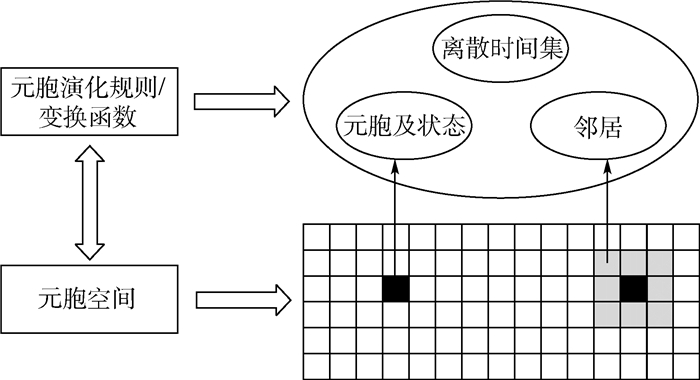
 下载:
下载:
